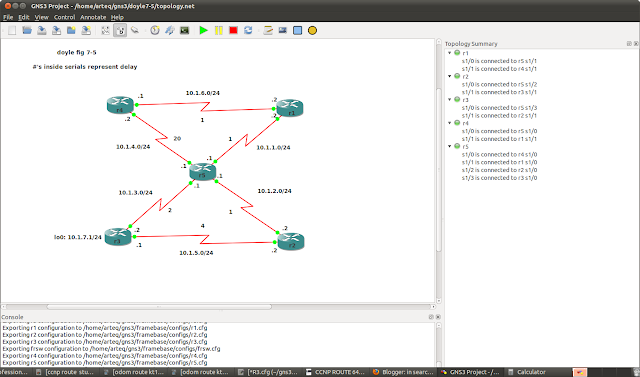i prefer reported distance (rd) over advertised distance (ad) because when i think of AD i think of administrative distance...
wendell calls it reported distance and doyle calls it advertised distance... make up my mind, please...
see below from: http://www.trainsignal.com/blog/ccnp-route-exam-help
When preparing for the ROUTE exam, an understanding of EIGRP theory is essential. One of the concepts that seems to be the most misunderstood is the difference between feasible distance and advertised distance.
To explain the difference between the feasible distance and the advertised (sometimes called reported distance) is easy, but many times it is overthought and ends up confusing people. Simply put, the advertised distance for a specific route to a destination must be less than (<) the feasible distance for that network (the best route to the destination). When there is only one path to a destination, the advertised distance will always be less than the feasible distance, but when there are multiple paths this condition must be considered to avoid loops.
i'm schizophrenic, and so am i...
so let's test that with our beautiful doyle topology...
r2#sh ip route eigrp
Gateway of last resort is not set
10.0.0.0/8 is variably subnetted, 9 subnets, 2 masks
D 10.1.1.0/24 [90/512] via 10.1.2.1, 00:21:43, Serial1/0
D 10.1.3.0/24 [90/768] via 10.1.2.1, 00:21:43, Serial1/0
D 10.1.4.0/24 [90/5376] via 10.1.2.1, 00:21:43, Serial1/0
D 10.1.6.0/24 [90/768] via 10.1.2.1, 00:21:41, Serial1/0
D 10.1.7.0/24 [90/1024] via 10.1.2.1, 00:21:43, Serial1/0
the route to 10.1.6.0/24 from r2 has an administrative distance of 90 (eigrp) and it's successor metric is 768 (best, why it's in the route table, why it's successor)
there are two routes in the topology to 10.1.6.0/24...
r2#sh ip eigrp topo all-links
EIGRP-IPv4 Topology Table for AS(1)/ID(10.1.5.2)
Codes: P - Passive, A - Active, U - Update, Q - Query, R - Reply,
r - reply Status, s - sia Status
P 10.1.5.0/24, 1 successors, FD is 1024, serno 17
via Connected, Serial1/1
P 10.1.7.0/24, 1 successors, FD is 1024, serno 50
via 10.1.2.1 (1024/768), Serial1/0
via 10.1.5.1 (1280/256), Serial1/1
P 10.1.3.0/24, 1 successors, FD is 768, serno 47
via 10.1.2.1 (768/512), Serial1/0
via 10.1.5.1 (1536/512), Serial1/1
P 10.1.2.0/24, 1 successors, FD is 256, serno 18
via Connected, Serial1/0
via 10.1.5.1 (1792/768), Serial1/1
P 10.1.6.0/24, 1 successors, FD is 768, serno 52
via 10.1.2.1 (768/512), Serial1/0
via 10.1.5.1 (2048/1024), Serial1/1
P 10.1.4.0/24, 1 successors, FD is 5376, serno 49
via 10.1.2.1 (5376/5120), Serial1/0
via 10.1.5.1 (6656/5632), Serial1/1
P 10.1.1.0/24, 1 successors, FD is 512, serno 48
via 10.1.2.1 (512/256), Serial1/0
via 10.1.5.1 (1792/768), Serial1/1
but only one meets the feasibility condition, 768...
r2#sh ip eigrp topo
EIGRP-IPv4 Topology Table for AS(1)/ID(10.1.5.2)
Codes: P - Passive, A - Active, U - Update, Q - Query, R - Reply,
r - reply Status, s - sia Status
P 10.1.5.0/24, 1 successors, FD is 1024
via Connected, Serial1/1
P 10.1.7.0/24, 1 successors, FD is 1024
via 10.1.2.1 (1024/768), Serial1/0
via 10.1.5.1 (1280/256), Serial1/1
P 10.1.3.0/24, 1 successors, FD is 768
via 10.1.2.1 (768/512), Serial1/0
via 10.1.5.1 (1536/512), Serial1/1
P 10.1.2.0/24, 1 successors, FD is 256
via Connected, Serial1/0
P 10.1.6.0/24, 1 successors, FD is 768
via 10.1.2.1 (768/512), Serial1/0
P 10.1.4.0/24, 1 successors, FD is 5376
via 10.1.2.1 (5376/5120), Serial1/0
P 10.1.1.0/24, 1 successors, FD is 512
via 10.1.2.1 (512/256), Serial1/0
and therefore only shows with the all-links option... note all the routes to 7.0 and 3.0 show in plain sh ip eigrp topo... their feasible distances blow, but their reported distances do not... their reported distances are less than the feasible distance, but their feasible distances suck so they don't show up in the route table like the guy above said... they don't meet the feasibility condition...
look again at 7.0 and 3.0...
the fd's are 1280 and 1536 from 10.1.5.1, much higher than the fd's of the successors, 1024 and 768 respectively... they make it into the regular topology table because the reported distances, 256 and 512, are less than the successor fd...
conversely, the route from 10.1.5.1 to 10.1.6.0 has a much higher fd like the others, but this one has a higher rd (1024) than the successors fd 768... no chance to make it into the regular topology table as shown above...
P 10.1.6.0/24, 1 successors, FD is 768, serno 52
via 10.1.2.1 (768/512), Serial1/0
via 10.1.5.1 (2048/1024), Serial1/1
via 10.1.2.1 (768/512), Serial1/0
via 10.1.5.1 (2048/1024), Serial1/1


No comments:
Post a Comment